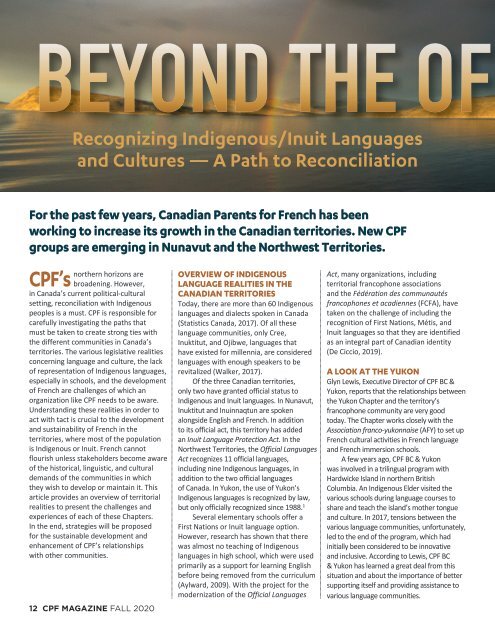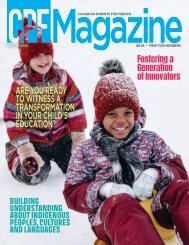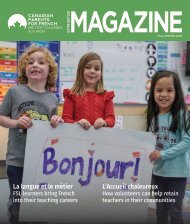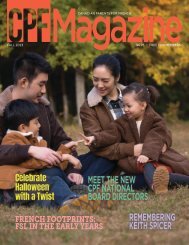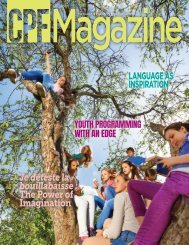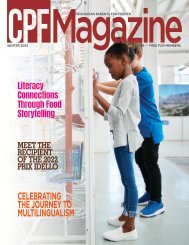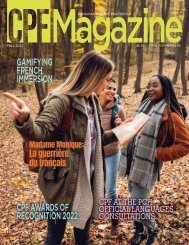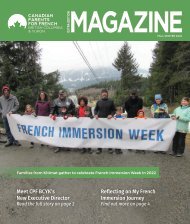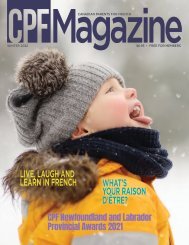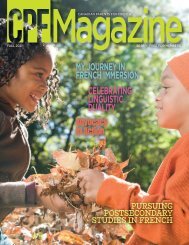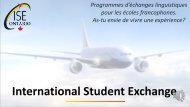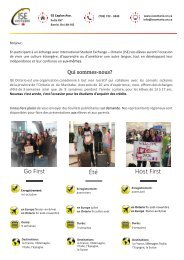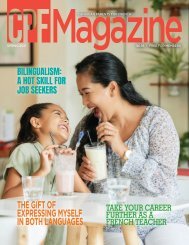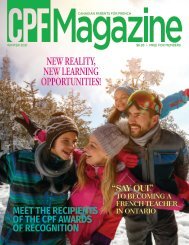CPF Magazine Fall 2020 Issue
A national network of volunteers, parents and stakeholders who value French as an integral part of Canada. CPF Magazine is dedicated to the promotion and creation of French-second-language learning opportunities for young Canadians.
A national network of volunteers, parents and stakeholders who value French as an integral part of Canada. CPF Magazine is dedicated to the promotion and creation of French-second-language learning opportunities for young Canadians.
Create successful ePaper yourself
Turn your PDF publications into a flip-book with our unique Google optimized e-Paper software.
BEYOND THE OF<br />
Recognizing Indigenous/Inuit Languages<br />
and Cultures — A Path to Reconciliation<br />
For the past few years, Canadian Parents for French has been<br />
working to increase its growth in the Canadian territories. New <strong>CPF</strong><br />
groups are emerging in Nunavut and the Northwest Territories.<br />
northern horizons are<br />
<strong>CPF</strong>’s broadening. However,<br />
in Canada’s current political-cultural<br />
setting, reconciliation with Indigenous<br />
peoples is a must. <strong>CPF</strong> is responsible for<br />
carefully investigating the paths that<br />
must be taken to create strong ties with<br />
the different communities in Canada’s<br />
territories. The various legislative realities<br />
concerning language and culture, the lack<br />
of representation of Indigenous languages,<br />
especially in schools, and the development<br />
of French are challenges of which an<br />
organization like <strong>CPF</strong> needs to be aware.<br />
Understanding these realities in order to<br />
act with tact is crucial to the development<br />
and sustainability of French in the<br />
territories, where most of the population<br />
is Indigenous or Inuit. French cannot<br />
flourish unless stakeholders become aware<br />
of the historical, linguistic, and cultural<br />
demands of the communities in which<br />
they wish to develop or maintain it. This<br />
article provides an overview of territorial<br />
realities to present the challenges and<br />
experiences of each of these Chapters.<br />
In the end, strategies will be proposed<br />
for the sustainable development and<br />
enhancement of <strong>CPF</strong>’s relationships<br />
with other communities.<br />
12 <strong>CPF</strong> MAGAZINE FALL <strong>2020</strong><br />
OVERVIEW OF INDIGENOUS<br />
LANGUAGE REALITIES IN THE<br />
CANADIAN TERRITORIES<br />
Today, there are more than 60 Indigenous<br />
languages and dialects spoken in Canada<br />
(Statistics Canada, 2017). Of all these<br />
language communities, only Cree,<br />
Inuktitut, and Ojibwe, languages that<br />
have existed for millennia, are considered<br />
languages with enough speakers to be<br />
revitalized (Walker, 2017).<br />
Of the three Canadian territories,<br />
only two have granted official status to<br />
Indigenous and Inuit languages. In Nunavut,<br />
Inuktitut and Inuinnaqtun are spoken<br />
alongside English and French. In addition<br />
to its official act, this territory has added<br />
an Inuit Language Protection Act. In the<br />
Northwest Territories, the Official Languages<br />
Act recognizes 11 official languages,<br />
including nine Indigenous languages, in<br />
addition to the two official languages<br />
of Canada. In Yukon, the use of Yukon’s<br />
Indigenous languages is recognized by law,<br />
but only officially recognized since 1988. 1<br />
Several elementary schools offer a<br />
First Nations or Inuit language option.<br />
However, research has shown that there<br />
was almost no teaching of Indigenous<br />
languages in high school, which were used<br />
primarily as a support for learning English<br />
before being removed from the curriculum<br />
(Aylward, 2009). With the project for the<br />
modernization of the Official Languages<br />
Act, many organizations, including<br />
territorial francophone associations<br />
and the Fédération des communautés<br />
francophones et acadiennes (FCFA), have<br />
taken on the challenge of including the<br />
recognition of First Nations, Métis, and<br />
Inuit languages so that they are identified<br />
as an integral part of Canadian identity<br />
(De Ciccio, 2019).<br />
A LOOK AT THE YUKON<br />
Glyn Lewis, Executive Director of <strong>CPF</strong> BC &<br />
Yukon, reports that the relationships between<br />
the Yukon Chapter and the territory’s<br />
francophone community are very good<br />
today. The Chapter works closely with the<br />
Association franco-yukonnaise (AFY) to set up<br />
French cultural activities in French language<br />
and French immersion schools.<br />
A few years ago, <strong>CPF</strong> BC & Yukon<br />
was involved in a trilingual program with<br />
Hardwicke Island in northern British<br />
Columbia. An Indigenous Elder visited the<br />
various schools during language courses to<br />
share and teach the island’s mother tongue<br />
and culture. In 2017, tensions between the<br />
various language communities, unfortunately,<br />
led to the end of the program, which had<br />
initially been considered to be innovative<br />
and inclusive. According to Lewis, <strong>CPF</strong> BC<br />
& Yukon has learned a great deal from this<br />
situation and about the importance of better<br />
supporting itself and providing assistance to<br />
various language communities.


